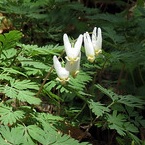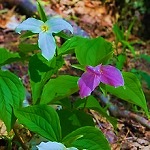FLORA FEATURE – Fleeting Flowers in the Woods
GET TO KNOW
Spring Ephemerals
In early spring, as the snow melts and the sun shines through barren branches, a carpet of flowers spreads across the woodland floor.
Fleeting in nature, these flowers sprout, bloom, and quickly fade away. They are the spring ephemerals, a group of early blooming woodland flowers that bring color, beauty, and new life to the desolate winter landscape. These lovely little plants take advantage of the brief time when bright spring sunshine reaches the forest floor before leaves appear and shade them out.
FUN FACT Warm blooded animals generate body heat by transforming starches into heat energy (thermogenesis). Only a handful of plants can also make internal heat . Skunk cabbage (Symplocarpus foetidus) a spring ephemeral, produces enough heat to melt snow and prevent its flowers from freezing at temperatures as low as 14⁰ F. The warm temperatures inside the oddly shaped flowers (known as shades) – plus a strong skunk like odor – are believed to attract early pollinators.
And while they may appear to be little more than bits of color on the forest floor, these hard-working plants provide a bounty of ecological benefits. Blooming as the weather changes from winter to spring, ephemerals help anchor soil and reduce run-off during heavy spring rains.
Additionally, some ephemerals serve as the primary early food source for native pollinators such as bumble bees, green metal bees, some miner bees, bee flies (bee imitators), and many types of flies.
And other ephemerals provide welcome food for desparately hungry woodland mammals and rodents.
Unfortunately, many of our wonderful spring ephemerals are becoming endangered. Our local varieties require rich, moist soils and survive best in virgin woodlands with deep layers of humus that have been untouched by human activity. Consequently, most types of human interference – flower collection, herbicide spraying, improper plantings, and land development – tend to harm these plants. Additionally, aggressive and invasive plant species, such as garlic mustard, are crowding and out-competing delicate ephemerals. And, invasive animal species, such as earthworms, can also damage woodland habitats. (Yes, earthworms are invasive and harmful to forests!) Large populations of earthworms (which are not native to Michigan) lead to excessively fast decomposition of forest floor vegetation and disrupt the humus layer that these plants depend on. However, under ideal conditions, some spring ephemerals (especially trout lily) form large and enduring colonies that may survive several hundred years.
PLANT SPECIFICATIONS
The various Michigan spring ephemerals are generally low growing (< 1ft in height), and many spread by underground rhizomes to form large carpet-like colonies.
Although numerous flowers may be casually called ephemerals, true spring ephemerals experience a complete die-off of foliage shortly after blooming. Consequently, the plants enjoy only a brief period each year for above ground (epigeous) growth. Then, for most of the year, these plants live only underground where they experience summer dormancy followed by a long, underground (hypogeous) growth phase. This extended underground growth period requires significant amounts of stored energy. And since spring ephemerals enjoy only a very brief period in the sun to absorb and store energy, these little plants excel at both cold temperature photosynthesis and energy storage.
In a clever example of mutualism, many spring ephemerals disperse seeds through a process known as myrmecochory. In such cases, the plant produces seeds that contain a special appendage, an eliaosome, that is made of dead cells and is high in both proteins and lipids. Eliaosomes are very nutritious, so “partner” ants happily carry the seeds back to the ant nest, eat the eliaosomes, and discard the seeds. It is a process that works well for both plants and ants.
In addition to our foul smelling skunk cabbage, (see Fun Fact box), some local favorite ephemerals are shown below.
Bloodroot
(Sanguinaria canadensis)
Photo by USFWS-Midwest
CC-BY-2.0
No nectar, only pollen for bees. Seed dispersal by ants. Orange fluid in stems and roots used as dye but toxic to mammals.
Dutchman’s breeches
(Dicentra cucullaria)
Photo by Kaja Schulz
CC-BY-2.0
Pollinated almost entirely by queen bumblebees. Seed dispersal by ants. Foliage toxic to mammals.
Eastern white trillium
(Trillium grandiflorum)
Photo by Joshua Mayer
CC-BY-2.0
Seed dispersal by ants. Plant often eaten by deer and rabbits.
Hepatica american
(Anemone hepatica var obtusa)
Photo by Fritz-Flohr-Reynolds
CC-BY-SA-2.0
No nectar, only pollen for bees and flies. Somewhat toxic to humans.
Spring beauty
(Claytonia virginica)
Photo by
Doug McGrady CC-BY-2.0
Early nectar and pollen for bees and flies. Seed dispersal by ants. Plant is edible.
Yellow trout lily
(Erythronium Americanum)
Photo by USFWS-SE
Public domain
Early nectar and pollen for bees and flies. Seed dispersal by ants. Plant edible in small quantities only.
TAKE ACTION
Healthy woodlands consist of four basic plant layers: the tree canopy, the understory (shrubs and brush), the field layer (low growing plants like the ephemerals), and the ground layer (mosses, lichens, and humus layer). All layers must exist in a balanced equilibrium to properly support each other and a wide range of animals. Consequently, if outside threats significantly damage key plants in one layer, the entire ecosystem can swing out of balance. Over time, this can lead to substantial changes in the overall plant and animal composition of the site.
At this time, there are significant threats to field level plants, such as spring ephemerals, in our local woodlands. Learn to identify spring ephemerals as well as the invasive plants that threaten them. Get to know garlic mustard, one of the most common invasives in Rouge woodlands, and pull it out before it goes to seed. Visit the Midwest Invasive Species Information Network to learn more. Plant natives and do not let any of your non-native garden plants like English Ivy expand into the woods and crowd out the ephemerals. Join our dedicated volunteers on workdays to learn how to identify and remove invasive plants and restore native vegetation.
MAIN PHOTO CREDIT: Photo of spring ephemerals in bloom in a woodland – photo by Deb Nysrom CC-BY-2.0 – image cropped












